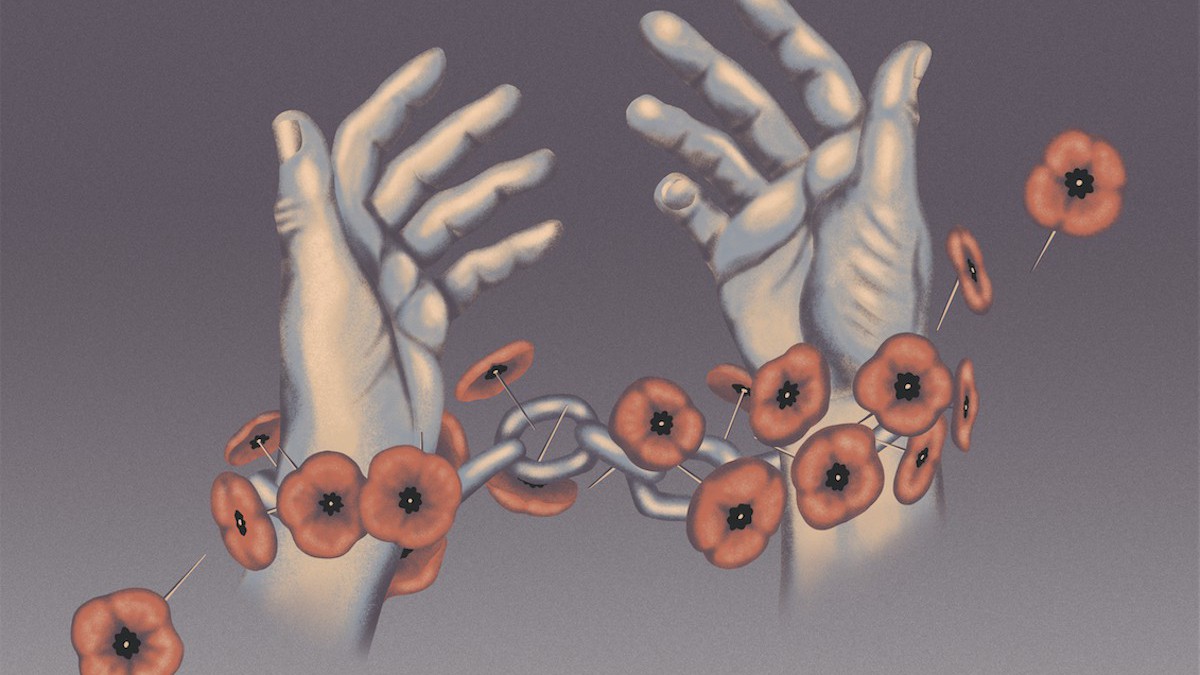This article uses person-first language, reflecting the long history of movements for justice for people labelled with intellectual/developmental disabilities. The language of “label” is responsive to the limitations and racist history of diagnostics. The disabled author prefers disability-first language.
Since 1921, red poppies have been bought and worn on Canadians’ lapels in remembrance of the violence of war. There has been much critique levelled at the poppies: many have pointed out that they glorify war and imperialism and falsely historicize Canada’s military expansion. In reality, Canada remains heavily invested in war. Just this year, the government announced it would spend a staggering $77 billion on buying a fleet of 15 new warships.
But since 2014, there’s been another reason to criticize the 19 million plastic poppies made and distributed each year: the poppies have been assembled in part by two groups of workers, both of which earn far less than the minimum wage.
Until 1996, poppies were produced by disabled veterans through a government-owned organization called VetCraft Industries. These were the first of what would come to be known as “sheltered workshops”: segregated workplaces or “training programs’’ for people with disabilities. When VetCraft closed in 1996, the Royal Canadian Legion took over poppy production, and in 2014 they signed a five-year contract with the TRICO Group to manage the production of the poppies. TRICO cut the poppies, then sub-contracted out the remainder of the assembly. That year, the Royal Canadian Legion spent $1.3 million on buying poppies and wreaths, and brought in revenue of $2.9 million from their sale, much of which went to war veterans and charities.
In the workshops, disabled workers build wooden crates, pick garlic, assemble windshield wiper tubes, make dog food, package student exam care packages, and pin poppies – usually for a few pennies per item.
Some of the workers who assembled the poppies were prisoners, who affixed the black poppy centre to its red petals with a pin. These prisoners were paid a maximum of $6.90 a day by the federal prison labour program, CORCAN.
The other workers are people labelled with intellectual/developmental disabilities (I/DD) who, like the disabled veterans of the 1900s, work in sheltered workshops. A 2015 Toronto Star investigation revealed that in sheltered workshops, workers were assembling poppies for $0.01 apiece. At that rate, they would have to assemble over 1,000 poppies an hour to earn minimum wage in Ontario.
The Royal Canadian Legion has not responded to Briarpatch’s inquiry about whether its poppies are still being assembled by prisoners or people labelled with I/DD.
Sheltered workshops are one of the most common types of employment for people labelled with I/DD. These segregated workplaces are often run by non-profits, and sometimes by the group homes workers live in – smaller versions of the asylums and institutions that disabled people were relegated to in the 19th and 20th centuries.
Incarceration and institutionalization
It’s no coincidence that prisoners and people with disabilities are both legally allowed to labour for less than minimum wage. A closer look at poppies and the workers who make them show us the connections between incarceration and institutionalization in Canada. At their core, both systems remove and isolate people from their communities under the guise of rehabilitation and support.
According to People First of Canada and the Canadian Association for Community Living, institutions are “any place in which people who have been labeled as having an intellectual disability are isolated, segregated and/or congregated. An institution is any place in which people do not have, or are not allowed to exercise, control over their lives and their day to day decisions. An institution is not defined merely by its size.”
While institutions are specifically designed to confine people labelled with I/DD, those same people – especially individuals with fetal alcohol spectrum disorders (FASDs) – are also overrepresented in prisons. A 2016 report of the Ontario Ombudsman found that in multiple cases, “incarceration became the failsafe when the developmental services sector could not provide adequate supports.”
Poverty also prevents people from living outside these institutions. How are you supposed to be able to save for two months’ rent in an apartment when you are being paid pennies an hour?
Institutions and prisons are not the same, but they exist along a continuum of coercion, confinement, and constraint. Medications like antipsychotics are disproportionately used off-label for incarcerated people and institutionalized people. Off-label use means that these drugs are being used not for their approved purposes – treating psychosis and bipolar disorder – but for sedating “difficult” patients and prisoners. Disability activist Judi Chamberlin called it the “chemical straitjacket.”
In Canada, when disabled people enter a prison or institution, they are often disqualified from receiving their regular disability income assistance – the justification is that institutions and prisons meet most of their needs, so regular income is unnecessary. But over time, these sites of incarceration have met fewer and fewer needs. Prisoners are now expected to pay for essentials like soap, stamps, snacks, over-the-counter medications, and menstrual products. In institutions, people labelled with I/DD are entitled to between $123 and $370 in monthly allowance, which is intended to cover internet, over-the-counter medication, transportation, cigarettes, and recreation.
This enforced poverty coerces people into working for less than minimum wage – either for CORCAN or through sheltered workshops – simply to survive their incarceration. Poverty also prevents people from living outside these institutions. How are you supposed to be able to save for two months’ rent in an apartment when you are being paid pennies an hour?
When one group of people can be paid less than minimum wage, or be exempt from labour regulations, all workers’ rights are under threat.
But prisons and institutions don’t promote sub-minimum wage labour as a means of survival. Instead, it is marketed as a form of rehabilitation and training. Sheltered workshops and prison labour programs both claim to provide “employment and employability skills training.” These programs promise to train participants for better jobs, but for many incarcerated and disabled people, the training lasts a lifetime. A survey found that 47 per cent of sheltered workshop workers are “in training” for more than five years, with 21 per cent being in the programs for between 10 and 20 years.
The connection between prisons and institutions, and their reliance on sub-minimum wage, is not new. We can trace it back to their literal foundations – which were built by the stolen labour of the people inside them.
The history of institutional labour
Prisons were the earliest form of institution for disabled people, who were among the first to be incarcerated, charged with lunacy and vagrancy. Prisoners were put to work to build their own cages during the 19th century, constructing the first prison in Ontario, the Kingston Penitentiary.
Responding to calls for reform of the care of the “feebleminded” and “insane,” the government began investing in the segregated incarceration of disabled people – building large-scale institutions like asylums, hospitals, and training schools. After the successful construction of the prison, superintendents put disabled and Mad inmates to work. Archival reports show that in the 19th century, unpaid inmates in Ontario asylums literally built their asylums’ walls, saving the provincial government “tens of thousands of dollars,” one asylum superintendent wrote.
In 1971, inmates and staff at the Rideau Regional Centre outside Ottawa planted, grew, picked, and sorted 433 tons of vegetables. This produce was used to feed and generate profits for the institution. People with less significant impairments were responsible for farming, cooking, and distributing food to their kin with more significant impairments. This set-up made it less desirable for institutions to discharge people, as they couldn’t afford to lose productive workers.
That same year, 1971, a watershed report was released. The Williston Report was a damning look at the conditions inside these institutions, following the death of Frederick Elijah Sanderson and abuse of Jean Marie Martel while in the custody of the Rideau Regional Centre. Both men had been sent to work as farmhands and to live with private farm owners nearby. While in separate homes, they were both paid deplorable wages of $5 per week while working for 5 to 15 hours per day. The report recommended, for the first time, that institutions for people with I/DD be closed.
Archival reports show that in the 19th century, unpaid inmates in Ontario asylums literally built their asylums’ walls, saving the provincial government “tens of thousands of dollars,” one asylum superintendent wrote.
But the Rideau Regional Centre remained open until 2009. In the meantime, carceral ableism adapted. Carceral ableism is the belief that people with some levels of disability will always require confinement. Group homes and sheltered workshops began replacing institutions, designed to alleviate the strain on institutions by providing services in the community. But these new systems were not integrated into the community – they continued to segregate and isolate people labelled with I/DD. Institutionalization adapted to the increasingly privatized economy, and third-party providers began to operate smaller institutions, often using public funds.
Today, group homes can reinforce many of the same systems of institutionalization they were designed to oppose. Group homes are deeply intertwined with sheltered workshops; some operators run workshops out of the homes, while other operators rely on workshops to provide day programming for their residents.
Sheltered workshops are largely exempt from employment standards acts, legalizing sub-minimum wage and unpaid overtime. In the workshops, disabled workers build wooden crates, pick garlic, assemble windshield wiper tubes, make dog food, package student exam care packages, and pin poppies – usually for a few pennies per item. In 2017 Ontario introduced a bill to make it mandatory to pay people with disabilities at least minimum wage, with a plan to close all sheltered workshops in the province by 2019. But in 2018, Doug Ford’s Conservative government delayed the bill. Today, sheltered workshops are still in use, both in Ontario and in other provinces.
Group homes are deeply intertwined with sheltered workshops; some operators run workshops out of the homes, while other operators rely on workshops to provide day programming for their residents.
The Ottawa-Carleton Association for Persons with Developmental Disabilities (OCAPDD) is one example of an entity that runs both group homes and sheltered workshops. OCAPDD is one of several developmental service agencies that was contracted by TRICO to assemble poppies at a penny apiece. The agency is funded by the Province of Ontario and operates 19 different types of residences and four enterprises. One of them is a profit-generating garlic farm, where people who live in OCAPPD housing are employed as “volunteers” to plant and harvest. To be clear, the agency is not paying people sub-minimum wage because it is strapped for cash – four of its executives make annual appearances on Ontario’s sunshine list, with their executive director, David Ferguson, making $174,000 last year.
Sheltered workshops are fundamentally at odds with the labour movement’s goals of fair pay, good working conditions, and bargaining power. Yet just this year, when Manitoba announced it would finally be closing the Manitoba Developmental Centre – a 131-year-old institution rife with allegations of sexual and physical abuse – the Manitoba Government and General Employees’ Union (MGEU) suggested that a sheltered workshop be expanded to fill the soon-to-be-empty space.
Worker movements
Worker organizing has been fundamental to disrupting these forms of wage theft. In the U.S. in the 1930s, disabled activists protested under the banner of the League of the Physically Handicapped to end the provisions that allowed for disabled people to be paid less than minimum wage. The league’s civil disobedience was successful in winning fairly-paid jobs for some disabled people. However, the league did not include people with more significant impairments or those labelled with I/DD who were largely institutionalized at the time. As a result, sheltered workshops continue in America – segregated from the community, with poor working conditions and pennies for pay.
Similarly single-issue social movements also failed prisoners. During the construction of the Kingston Penitentiary, trade unionists became concerned by the possibility that prisoners – who were being put to work doing everything from carpentry to shoemaking – would take their jobs. Masons in southern Ontario went on strike in 1853 to protest the use of incarcerated labour. Two decades later, the newly-formed Canadian Labor Union – the country’s first national labour federation – struck a committee on prison labour. The committee was not based on the principle that prison labour is unjust, nor did it try to improve the poor working conditions of prisoner-workers – instead, it aimed to stop prisoners from being taught trades.
Instead of pitting unionized workers against non-unionized workers in a race to the bottom, the labour movement should invite in disabled and incarcerated workers, to strengthen its demand for a fair day’s wage for a fair day’s work.
When social movements are inclusive – led by and committed to solidarity with the most oppressed people – they achieve lasting success. Prisoner-workers understood that capitalists wanted to use them as a reserve army of cheap, non-unionized labourers in order to replace the more expensive unionized staff – so workers incarcerated in prisons demanded recognition within the labour movement and pushed, sometimes successfully, for unionization. In 1977, prisoner-workers in the Guelph Correctional Centre abattoir successfully unionized with the Canadian Food and Allied Workers, forming a bargaining unit alongside their non-incarcerated co-workers.
Demanding disability justice
No one should be doing piecework for one cent a poppy. When one group of people can be paid less than minimum wage, or be exempt from labour regulations, all workers’ rights are under threat. Instead of pitting unionized workers against non-unionized workers in a race to the bottom, the labour movement should invite in disabled and incarcerated workers, to strengthen its demand for a fair day’s wage for a fair day’s work.
These two ideas – of equal work for equal pay, and human worth distinct from productivity – allow us to challenge the capitalist state and its drive for profit and punishment.
Over time, capitalism has learned to integrate those on the margins, like prisoners and disabled people – reducing them, like all of us, to how much they can produce. But disability justice activists have long been pushing back against the notion that a person’s value is based on their productivity. Sins Invalid, a collective of disabled and Mad queer and trans people of colour, developed the “10 Principles of Disability Justice,” in which they argue that “[i]n an economy that sees land and humans as components of profit, we are anti-capitalist by the nature of having non-conforming body/minds.”
These two ideas – of equal work for equal pay, and human worth distinct from productivity – allow us to challenge the capitalist state and its drive for profit and punishment. They allow us to say no to war and imperialism, no to $77 billion in warships, no to prisons and institutions. And they shape our demands for what we deserve: supports for decarceration and community living, investments in care work, livable disability income supports, and real wages.







